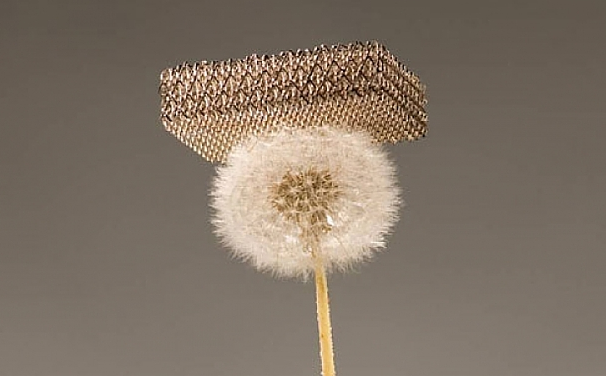Move over aluminum—it’s time for microlattice to revolutionize aeronautical engineering. Developed by Boeing, microlattice is the world’s lightest metal, comprised of 99.99% air amidst a series of thin, hollow struts. The 3D open cellular polymer structure makes this material incredibly lightweight. So light, in fact, that it can balance atop a dandelion!
At the same time, microlattice is impressively strong, due to its structure that mimics that of human bones: a rigid outside coupled with a hollow, open cellular interior. It’s also less brittle than bones, designed with a compressible grid structure that allows it to absorb a large amount of energy and then spring back into shape, similar to a sponge. What’s more, microlattice floats down to the ground like a feather when dropped. Surely something with such an elegant design mirroring that of the natural world has the potential to radically alter the way we construct aircrafts, cars, and more.
 Boeing makes this breakthrough easy to understand with a familiar scenario that we’ve all likely done in high school science class: the egg drop challenge. The usual method for dropping an egg from multiple stories involves padding it in bubble wrap and hoping for the best. With microlattice, Boeing has essentially created a structure that could closely surround the egg and absorb all of the force of impact, without a lot of bulk. So your eggs won’t get scrambled.
Boeing makes this breakthrough easy to understand with a familiar scenario that we’ve all likely done in high school science class: the egg drop challenge. The usual method for dropping an egg from multiple stories involves padding it in bubble wrap and hoping for the best. With microlattice, Boeing has essentially created a structure that could closely surround the egg and absorb all of the force of impact, without a lot of bulk. So your eggs won’t get scrambled.
In real world applications, we can expect to see microlattice replacing traditional materials used to construct airplanes and rockets. Replacing even a small percentage of the aluminum commonly used in aircrafts with microlattice could lead to significant reductions in the overall weight of the aircraft. A lighter plane requires less fuel, thereby providing a huge cost-saving incentive. With fuel being the lion’s share of airline operating costs, reducing the amount of gas needed would provide a huge cost saving measure that would trickle down to consumer prices with lower ticket prices. Most importantly, microlattice’s impressive strength and flexibility upon impact means that performance would not be hampered by lightening the load, but instead could enhance the overall durability and safety of aircrafts.
While microlattice was first invented by scientists at UC Irvine, HRL Laboratories and Caltech back in 2011, it’s just now coming into viable applications through Boeing’s further development. This isn’t the first time that Boeing has revolutionized aircraft engineering. With the design of the 787 Dreamliner that made its debut in 2008, Boeing introduced the first plane whose fuselage was made of one=piece composite barrel sections instead of aluminum panels. Combined with new carbon fiber materials, the 787 became the most fuel efficient plane in its class.
Imagine how Boeing’s ongoing innovations, coupled with microlattice, will change the aerospace game even more. With panels or sidewalls made of microlattice, commercial jets would be lighter, stronger, and more fuel efficient. It’s only a matter of time until we see this amazing new wonder material taking to the skies, and it’s likely that other earthbound applications will be discovered as well. For microlattice, the sky’s the limit.

